The Guide to Stakeholder Mapping: Techniques, Tools, and Best Practices
Organizations implement a technique to identify, analyze and document the roles and relationships of individuals and groups for a project called as “Stakeholder Mapping“, which indicates a strategic visualization.
To understand complex network of stakeholders this approach helps project managers and business leaders to streamline their process.
Key Highlights
- Strategic Stakeholder Analysis Methods
- Power-Interest Grid Implementation
- Engagement Plan Development
- Risk Assessment Techniques
What is Stakeholder Mapping?
Stakeholder mapping is a strategic tool that is used to visualize and analyze the relationships between various parties involved in a project or business initiative.
This process helps project managers identify key players, assess their influence, and develop targeted engagement strategies.
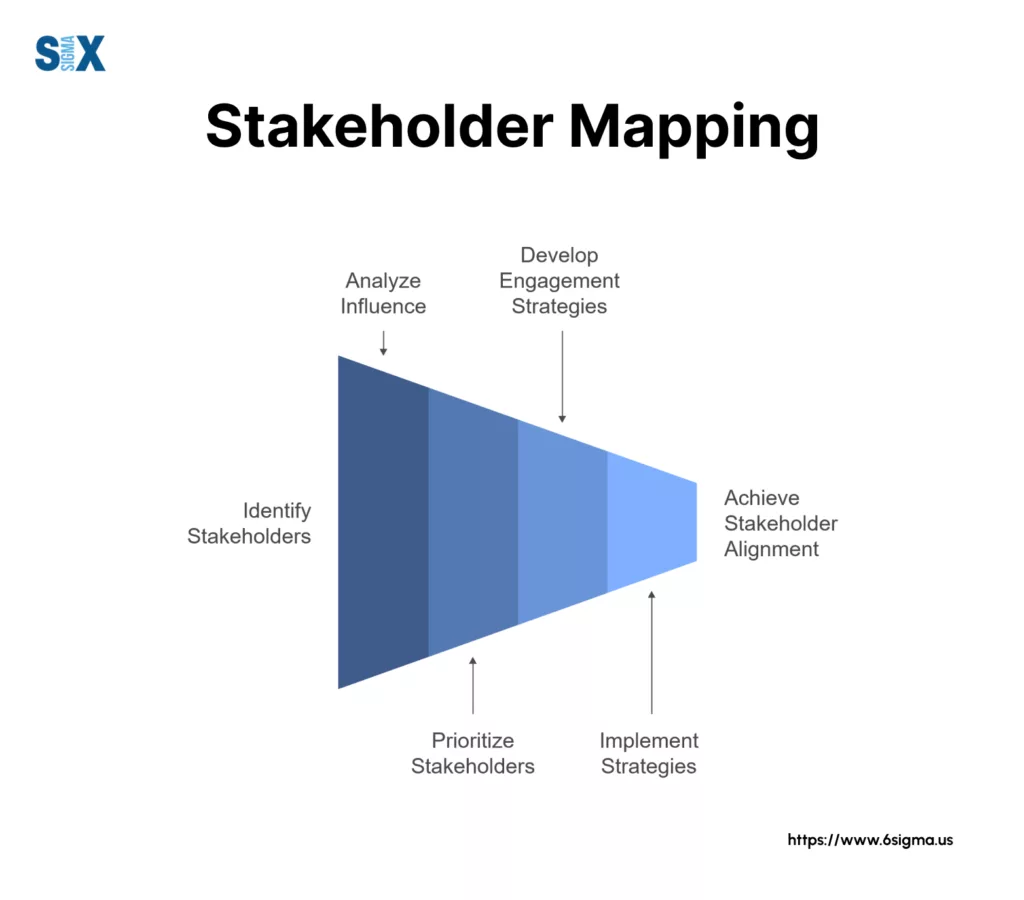
Types of Stakeholders in Business Projects
The first step in stakeholder mapping involves categorizing different types of stakeholders based on their relationship with the organization.
These categories help project managers create more focused and effective communication strategies.
Internal stakeholders operate within the organization and directly influence daily operations. This group includes:
- Board members and executives
- Department managers
- Project team members
- Regular employees
External stakeholders exist outside the organizational structure but maintain significant influence over project outcomes.
These typically include:
- Customers and end-users
- Suppliers and vendors
- Government regulators
- Local communities
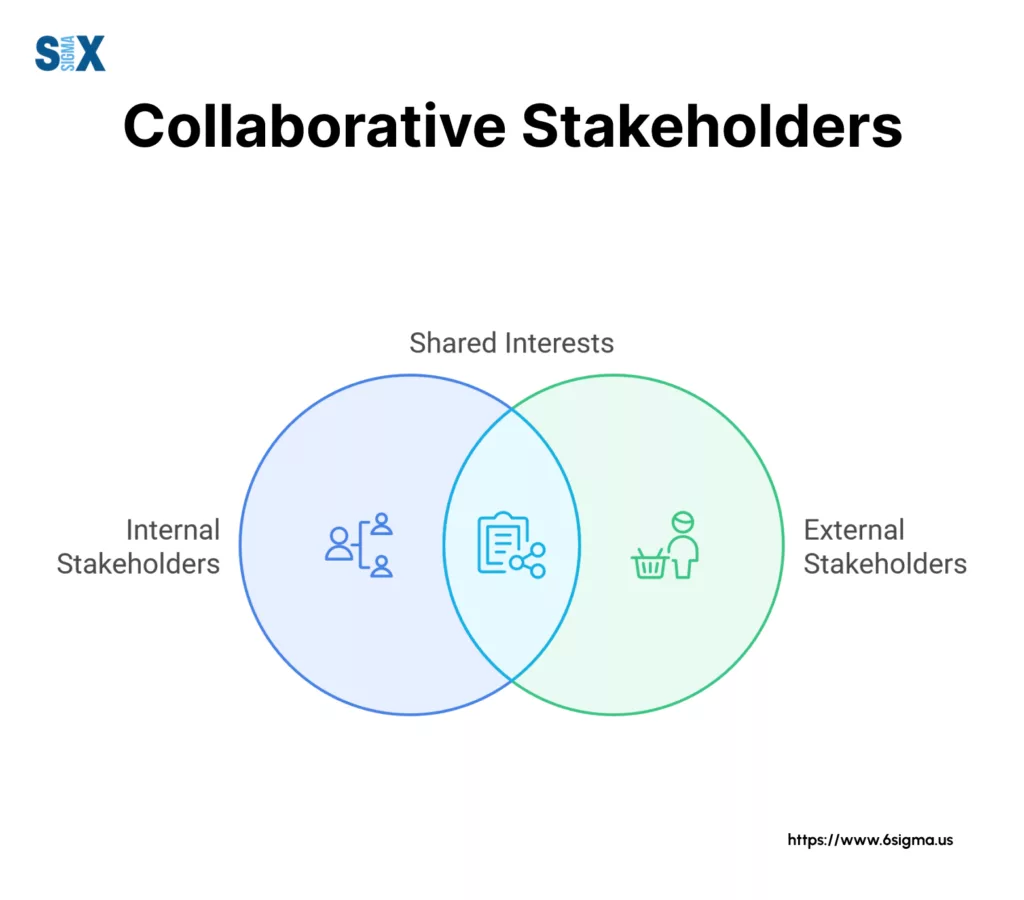
Primary and Secondary Stakeholder Classification
Primary stakeholders hold direct interest in project outcomes and maintain significant influence over decision-making processes.
These stakeholders often include investors, customers, and key employees. Their involvement proves essential for project success.
Secondary stakeholders exercise indirect influence but remain important for long-term success. Media organizations, industry analysts, and competing businesses fall into this category.
While their immediate impact might seem limited, their influence can significantly affect project outcomes over time.
Identifying Key Project Stakeholders with Stakeholder Mapping
The stakeholder identification process requires systematic analysis of all parties affected by or interested in project outcomes. Project managers must consider:
- Financial relationships
- Operational dependencies
- Legal obligations
- Market influence
Organizations often conduct stakeholder interviews and surveys to gather detailed information about interests, concerns, and expectations.
Stakeholder Influence Assessment
Evaluating stakeholder influence involves analyzing multiple factors:
- Decision-making authority
- Resource control
- Technical expertise
- Market position
Project managers use this information to prioritize stakeholder engagement efforts and allocate resources effectively.
Regular reassessment ensures stakeholder maps remain current and useful throughout the project lifecycle.
The stakeholder mapping process requires continuous updates as project circumstances change and new stakeholders emerge.
Master process mapping to enhance your stakeholder management skills.
Learn how to create detailed process maps that visualize stakeholder relationships.
The Stakeholder Mapping Process: A Five-Step Approach
The stakeholder mapping process requires methodical execution to ensure accurate representation of all project relationships.
Organizations that follow these structured steps create more effective stakeholder engagement strategies and achieve better project outcomes.
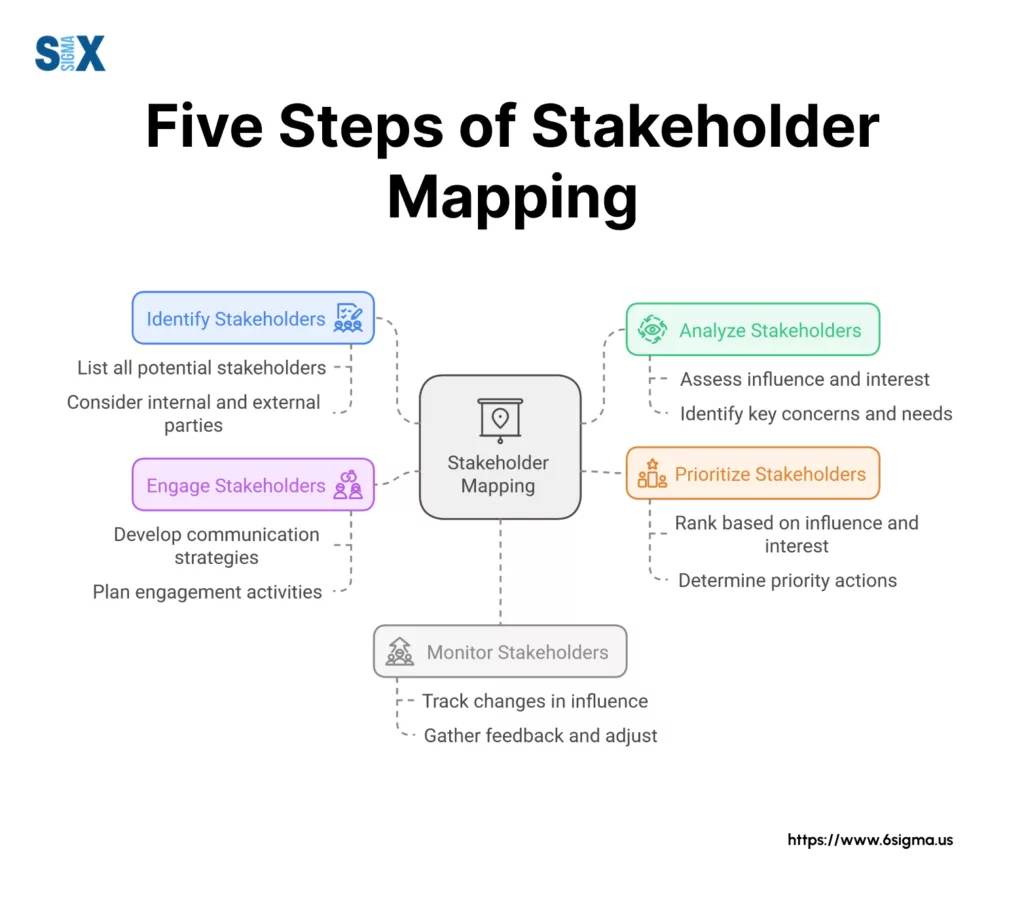
Step 1: Identify Project Stakeholders
The initial phase focuses on discovering all parties connected to the project. Project managers must consider both obvious and less apparent stakeholders who might influence project success.
This identification process includes reviewing:
- Project documentation
- Organizational charts
- Previous project records
- Industry regulations
- Market analysis reports
Step 2: Analyze Stakeholder Characteristics
Stakeholder analysis examines each identified party’s specific traits and potential impact on the project. This step evaluates:
- Power levels and authority
- Interest in project outcomes
- Influence over other stakeholders
- Resource control capabilities
- Communication preferences
Project teams should document these characteristics systematically, using standardized assessment criteria to maintain consistency across different stakeholder groups.
Step 3: Prioritize Key Stakeholders with Stakeholder Mapping
Prioritization helps organizations allocate resources effectively by focusing on stakeholders who require immediate attention. The process typically considers:
- Impact level on project success
- Urgency of stakeholder needs
- Relationship strength
- Historical engagement patterns
This step produces a ranked list of stakeholders, enabling project managers to develop targeted engagement strategies based on stakeholder importance.
Step 4: Create The Stakeholder Map
The actual mapping phase involves placing stakeholders on a visual representation that shows their relationships and influence levels.
Project managers often use specialized software tools to create these maps, which might include:
- Power-interest grids
- Influence-impact matrices
- Stakeholder circles
- Network diagrams
These visual tools help teams understand complex stakeholder relationships and identify potential collaboration opportunities or conflict areas.
Step 5: Develop Engagement Strategies with Stakeholder Mapping
The final step transforms stakeholder mapping insights into actionable engagement plans. This phase includes:
- Creating communication schedules
- Designing specific engagement activities
- Establishing feedback mechanisms
- Setting measurement criteria
Organizations must tailor these strategies to match stakeholder preferences and project requirements. Regular strategy reviews ensure continued alignment with stakeholder needs and project goals.
Implementation and Monitoring
The stakeholder mapping process requires regular updates as project conditions change. Project managers should:
- Schedule periodic review sessions
- Track engagement effectiveness
- Document stakeholder feedback
- Adjust strategies as needed
Success metrics help teams evaluate the effectiveness of their stakeholder mapping efforts and make necessary adjustments throughout the project lifecycle.
This systematic approach to stakeholder mapping enables organizations to maintain strong relationships with key stakeholders while managing project risks effectively.
Take your stakeholder mapping skills to the next level with our comprehensive Define Phase course
Stakeholder Mapping Techniques and Models
Project managers employ various stakeholder mapping techniques to visualize and analyze stakeholder relationships effectively.
Each model serves specific organizational needs and provides unique insights into stakeholder dynamics.
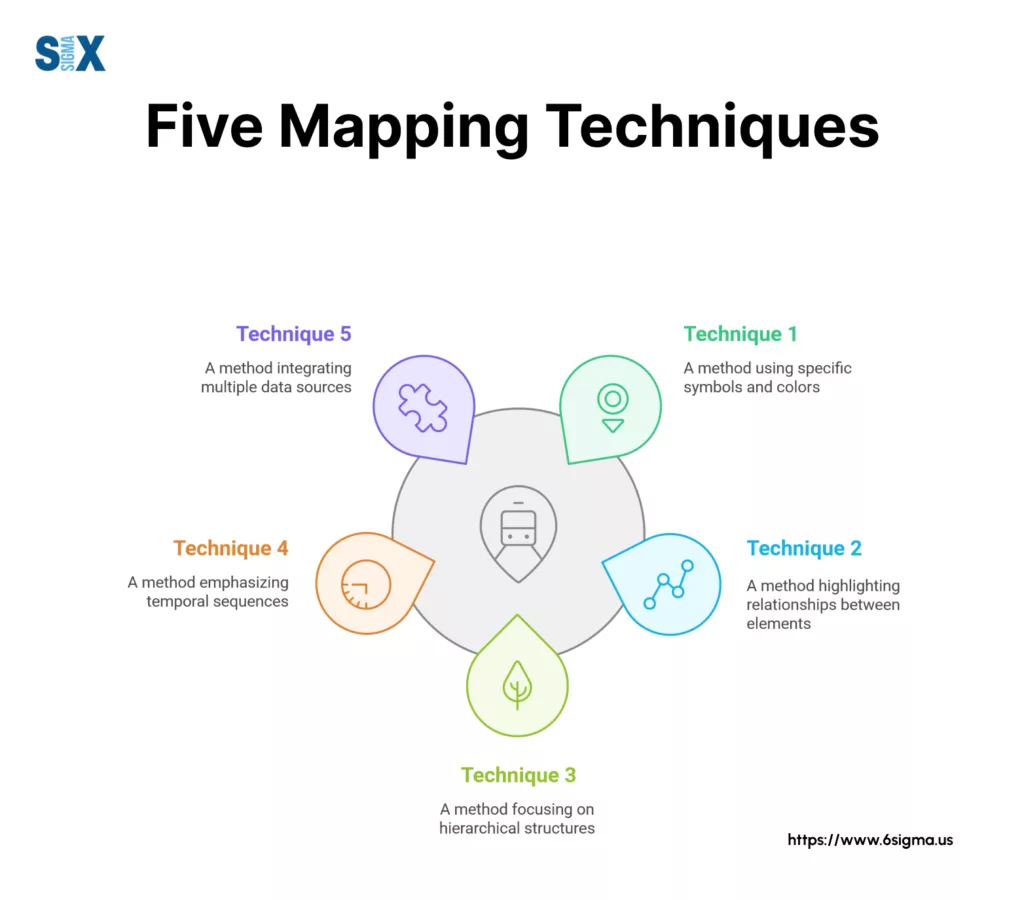
The Power/Interest Grid Model
The Power/Interest grid divides stakeholders into four quadrants based on their level of power and interest in the project.
This stakeholder mapping framework helps determine appropriate engagement strategies for each group:
- High Power/High Interest: Require close management and frequent engagement
- High Power/Low Interest: Need sufficient information and monitoring
- Low Power/High Interest: Demand regular updates and consultation
- Low Power/Low Interest: Minimal effort required for monitoring
Understanding The Salience Model with Stakeholder Mapping
The Salience model evaluates stakeholders based on three key attributes: power, legitimacy, and urgency.
This technique creates seven distinct stakeholder categories:
- Dormant Stakeholders (power only)
- Discretionary Stakeholders (legitimacy only)
- Demanding Stakeholders (urgency only)
- Dominant Stakeholders (power and legitimacy)
- Dangerous Stakeholders (power and urgency)
- Dependent Stakeholders (legitimacy and urgency)
- Definitive Stakeholders (all three attributes)
The Stakeholder Circle Approach
The Stakeholder Circle provides a visual representation of relative stakeholder importance through concentric rings.
This model emphasizes:
- Distance from center indicates influence level
- Size of segment shows relative importance
- Color coding represents stakeholder categories
- Patterns indicate relationship types
Implementing The Influence/Impact Matrix
The Influence/Impact matrix plots stakeholders according to their ability to influence project outcomes and the potential impact of the project on them.
This stakeholder mapping matrix guides resource allocation and communication strategies through four key segments:
- High Influence/High Impact
- High Influence/Low Impact
- Low Influence/High Impact
- Low Influence/Low Impact
Stakeholder Engagement Assessment Matrix
This advanced mapping technique evaluates current versus desired engagement levels for each stakeholder.
The matrix uses five engagement states:
- Unaware
- Resistant
- Neutral
- Supportive
- Leading
Project teams track stakeholder movement between these states to measure engagement effectiveness and adjust strategies accordingly.
Selecting The Right Stakeholder Mapping Technique
Organizations should consider several factors when choosing a stakeholder mapping approach:
- Project complexity and scale
- Available resources and time
- Organizational culture
- Stakeholder diversity
- Project objectives
Many successful projects combine multiple mapping techniques to gain deeper insights into stakeholder relationships and influence patterns.
Implementation Guidelines
Effective implementation of these stakeholder mapping techniques requires:
- Regular updates and revisions
- Consistent evaluation criteria
- Clear documentation procedures
- Team alignment on methodology
- Flexible adaptation to changing conditions
Project managers should review and adjust their chosen mapping approach based on project phase and emerging stakeholder dynamics.
These mapping techniques provide structured frameworks for understanding and managing stakeholder relationships throughout the project lifecycle
Creating a Stakeholder Map: Step-by-Step Guide
Building an effective stakeholder map requires careful planning and systematic execution.
This guide outlines the essential steps and provides practical examples to help project teams create useful stakeholder maps.
Step 1: Gather Essential Project Information
The first phase involves collecting relevant project documentation and data. Project managers should review project charters, business cases, and organizational charts.
This information forms the foundation for identifying potential stakeholders and their relationships to the project.
Step 2: Select Appropriate Mapping Tools
Choose suitable tools based on project requirements. Digital options include specialized stakeholder mapping software, while traditional methods might use whiteboards or large paper sheets.
Each tool offers different advantages:
- Digital Tools: Enable easy updates and sharing
- Spreadsheet Software: Provides detailed data tracking
- Visual Mapping Tools: Create professional diagrams
- Physical Methods: Support collaborative sessions
Step 3: Draft The Initial Framework for Stakeholder Mapping
Begin by creating the basic structure of your stakeholder map.
Draw the central project element and establish clear boundaries for different stakeholder categories.
For example stakeholder maps often use concentric circles to indicate levels of influence or involvement.
Step 4: Place Stakeholders On The Map
Position each identified stakeholder according to their relationship with the project. Consider these key factors:
- Distance from center (influence level)
- Grouping with similar stakeholders
- Relationship connections
- Power dynamics
- Interest levels
Step 5: Draw Relationship Lines
Indicate connections between stakeholders using appropriate line styles:
- Solid lines: Strong relationships
- Dashed lines: Indirect connections
- Arrows: Direction of influence
- Line thickness: Relationship strength
Step 6: Add Supporting Information
Enhance the map with relevant details that aid understanding:
- Stakeholder roles
- Contact information
- Key concerns
- Influence levels
- Engagement preferences
Tips For Effective Stakeholder Mapping
Several practices ensure the creation of useful stakeholder maps:
- Maintain consistent naming conventions
- Use clear visual hierarchies
- Include map creation date
- Document assumptions
- Schedule regular updates
Common Stakeholder Mapping Challenges
Project teams often encounter specific challenges during the mapping process:
- Information gaps
- Changing stakeholder roles
- Complex relationships
- Limited resources
- Time constraints
Quality Assurance Steps
Before finalizing the stakeholder map, verify its accuracy through these measures:
- Cross-reference with project documents
- Validate stakeholder positions
- Review relationship connections
- Check completeness of information
- Confirm visual clarity
Maintaining The Stakeholder Map
Regular maintenance ensures the continued usefulness of stakeholder maps:
- Schedule periodic reviews
- Update stakeholder information
- Adjust relationships as needed
- Document significant changes
- Share updates with team members
This structured approach to creating stakeholder maps helps project teams develop effective tools for stakeholder management.
Regular updates and careful attention to detail ensure the maps remain valuable throughout the project lifecycle.
Best Practices for Effective Stakeholder Mapping
Successful stakeholder mapping requires adherence to established best practices that ensure accuracy, completeness, and practical value.
Organizations that follow these guidelines create more effective stakeholder maps and achieve better project outcomes.
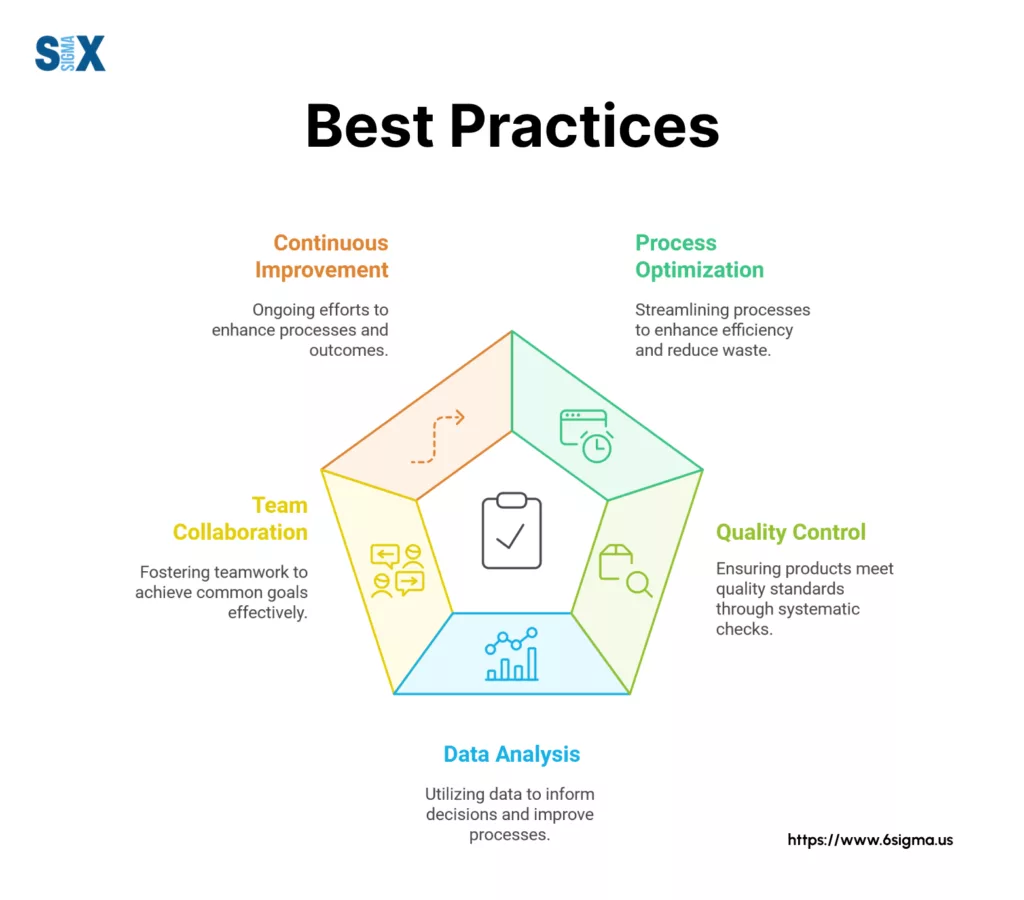
Ensuring Accuracy and Completeness
Accuracy in stakeholder mapping begins with thorough data collection and verification. Project teams should establish clear criteria for stakeholder identification and classification.
Regular validation sessions with key team members help maintain data quality and ensure all relevant stakeholders receive appropriate consideration.
Documentation plays a crucial role in maintaining accuracy.
Teams should record the rationale behind stakeholder classifications, relationship assessments, and influence determinations.
Maintaining Current Stakeholder Information
Stakeholder maps require regular updates to reflect changing project conditions and organizational relationships.
Project managers should establish specific triggers for map updates, such as project phase transitions, organizational changes, or significant stakeholder feedback.
Update procedures should include mechanisms for capturing new stakeholder information, reassessing existing relationships, and documenting changes.
Integration of Stakeholder Mapping With Business Processes
Stakeholder mapping provides maximum value when integrated with other business processes.
Project teams should align mapping activities with strategic planning, risk management, and communication planning. This integration ensures stakeholder considerations influence key business decisions.
This connection helps teams anticipate stakeholder needs during project planning and execution phases, leading to more effective stakeholder engagement strategies.
Quality Control Measures
Implementing quality control measures helps maintain the integrity of stakeholder maps.
Regular audits should examine the completeness of stakeholder information, accuracy of relationship assessments, and effectiveness of engagement strategies.
These reviews help identify gaps or inconsistencies that require attention.
Stakeholder Feedback Integration
Effective stakeholder mapping incorporates feedback from the stakeholders themselves.
Organizations should establish channels for stakeholders to provide input on their roles, relationships, and engagement preferences.
This feedback helps validate mapping assumptions and improves engagement effectiveness.
Technology Utilization for Stakeholder Mapping
Modern stakeholder mapping benefits from appropriate technology solutions. Organizations should select tools that support their mapping needs while enabling easy updates and sharing.
Digital platforms often provide additional features for tracking engagement history and measuring relationship strength.
Training and Skill Development
Organizations must invest in training team members responsible for stakeholder mapping activities.
This training should cover mapping methodologies, tool usage, and best practices for stakeholder engagement.
Regular skill development ensures teams maintain the expertise needed for effective stakeholder mapping.
This clarity helps maintain consistency in mapping approaches across different projects.
Common Mistakes and Challenges in Stakeholder Mapping
Project teams often encounter specific obstacles when conducting stakeholder mapping exercises.
Understanding these challenges helps organizations develop more effective mapping strategies and avoid common pitfalls that can diminish project success.
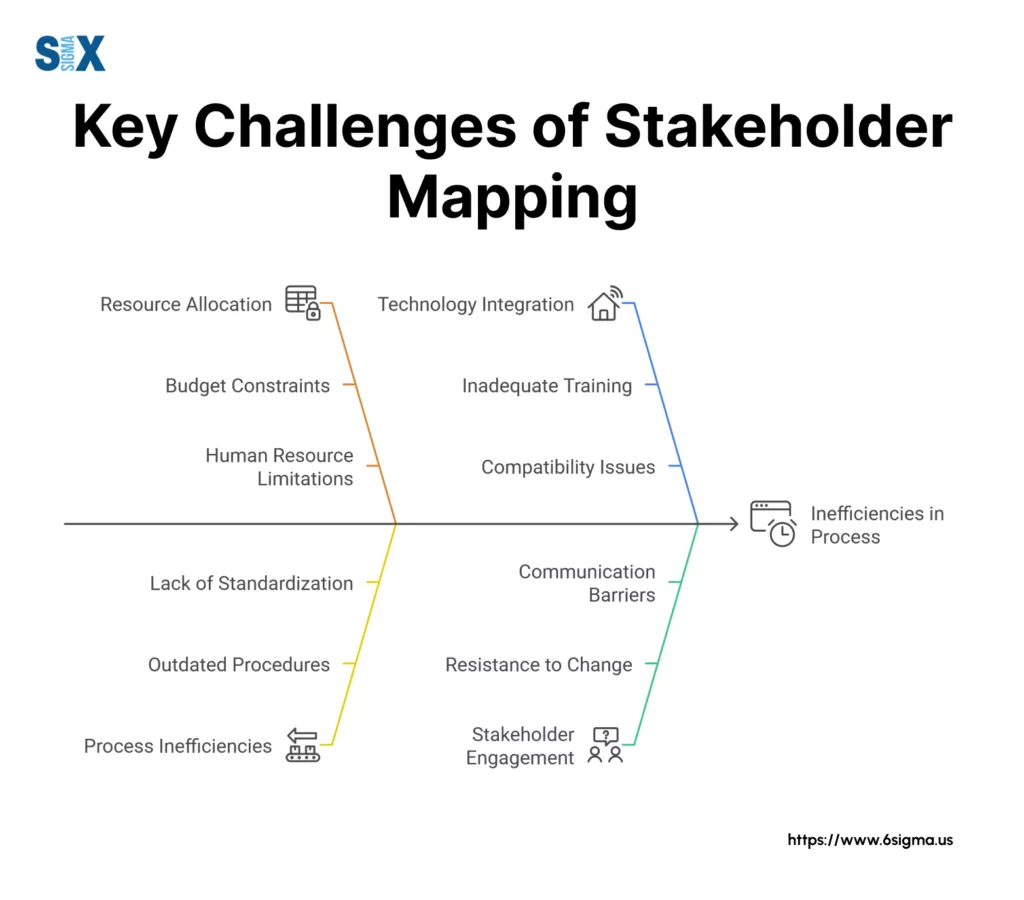
Overlooking Critical Stakeholders
One significant error in stakeholder mapping occurs when teams fail to identify all relevant stakeholders. This oversight typically results from rushed analysis or narrow project perspectives.
Organizations must examine both direct and indirect project connections to ensure complete stakeholder identification.
Project managers should consider stakeholders from multiple angles, including regulatory bodies, community groups, and internal departments.
Misclassifying Stakeholder Influence Levels
Incorrect assessment of stakeholder influence creates flawed engagement strategies.
Teams sometimes underestimate the power of informal influence networks or overemphasize formal authority structures.
This misclassification leads to inappropriate resource allocation and ineffective communication plans.
Organizations need structured evaluation criteria to assess stakeholder influence accurately.
Static Stakeholder Maps
Many organizations treat stakeholder mapping as a one-time exercise rather than an ongoing process.
This static approach fails to capture changing stakeholder relationships and emerging project dynamics. Project teams must regularly update their stakeholder maps to reflect evolving project conditions.
Regular review sessions should examine changes in stakeholder positions, relationships, and influence levels.
These updates help maintain the relevance and effectiveness of stakeholder engagement strategies throughout the project lifecycle.
Insufficient Data Collection in Stakeholder Mapping
Poor stakeholder mapping often stems from inadequate information gathering.
Teams might rely on outdated data or make assumptions without proper verification. This approach leads to incomplete stakeholder profiles and ineffective engagement strategies.
Project managers should establish systematic data collection processes that capture relevant stakeholder information from multiple sources.
Regular data validation helps ensure accuracy and completeness of stakeholder profiles.
Ignoring Stakeholder Feedback
Some organizations conduct stakeholder mapping exercises without incorporating input from the stakeholders themselves.
This oversight can result in misaligned engagement strategies and missed opportunities for collaboration.
Teams should create mechanisms for stakeholder feedback and incorporate this information into their mapping updates.
Regular stakeholder consultations help validate mapping assumptions and improve engagement effectiveness.
Poor Integration of Stakeholder Mapping With Project Processes
Organizations sometimes treat stakeholder mapping as an isolated activity rather than integrating it with other project management processes.
This disconnection reduces the practical value of stakeholder maps and limits their impact on project decisions.
Project teams should align stakeholder mapping with strategic planning, risk management, and communication activities.
This integration ensures stakeholder considerations influence key project decisions and activities.
Inadequate Resource Allocation
Many projects underestimate the resources required for effective stakeholder mapping. This limitation can result in rushed analysis, incomplete data collection, or infrequent updates.
Organizations must allocate sufficient time and resources to maintain accurate stakeholder maps.
Project managers should budget for regular mapping activities, including data collection, analysis, and updates.
Implementation Solutions
Organizations can address these challenges through structured approaches:
- Establish clear mapping protocols
- Implement regular review cycles
- Develop stakeholder feedback channels
- Allocate adequate resources
- Integrate mapping with project processes
These solutions help teams create more accurate and useful stakeholder maps while avoiding common pitfalls in the mapping process.
FAQs
Stakeholder mapping represents a strategic visualization technique used to analyze and document the influence and interest of various parties involved in a project.
The stakeholder mapping process consists of four essential steps. First, teams identify all relevant stakeholders through systematic analysis of project documentation and organizational relationships. Second, they analyze each stakeholder’s influence and interest levels. Third, teams categorize stakeholders based on their potential impact on project success. Finally, they develop targeted engagement strategies for each stakeholder group.
A stakeholder map should include all parties who influence or are influenced by the project. Internal stakeholders typically include employees, managers, and department heads. External stakeholders often encompass customers, suppliers, regulators, and community groups. Project teams must also consider indirect stakeholders such as media outlets, industry associations, and competing organizations that might affect project outcomes.
The most effective stakeholder mapping tools depend on specific project requirements and organizational needs. Digital solutions like specialized stakeholder management software offer features for real-time updates and collaboration. Traditional tools such as spreadsheets and visual mapping software provide flexibility for smaller projects.
Creating an effective stakeholder map begins with gathering comprehensive project information and identifying all relevant stakeholders. Teams then assess each stakeholder’s influence and interest levels using established criteria. The engagement plan develops from this analysis, outlining specific communication strategies and interaction frequencies for each stakeholder group.
Stakeholder mapping requires significant time and resource investment for proper implementation. The process can become complex when dealing with numerous stakeholders or intricate relationship networks. Maps may quickly become outdated without regular updates, potentially leading to misaligned engagement strategies.
Organizations often encounter several challenges during stakeholder mapping. Accurate assessment of stakeholder influence levels requires detailed analysis and validation. Teams might struggle to maintain current information as stakeholder relationships evolve. Resource constraints can limit the frequency of map updates and stakeholder engagement activities.
Stakeholder maps require regular updates to maintain their effectiveness. Project teams should review and update maps at key project milestones or when significant changes occur in the stakeholder environment. Monthly or quarterly reviews help ensure maps reflect current stakeholder relationships and influence levels.
Effective stakeholder maps provide clear visualization of relationships and influence levels. They must include accurate stakeholder information and reflect current project conditions. Good maps facilitate easy updates and sharing across project teams.
SixSigma.us offers both Live Virtual classes as well as Online Self-Paced training. Most option includes access to the same great Master Black Belt instructors that teach our World Class in-person sessions. Sign-up today!
Virtual Classroom Training Programs Self-Paced Online Training Programs







